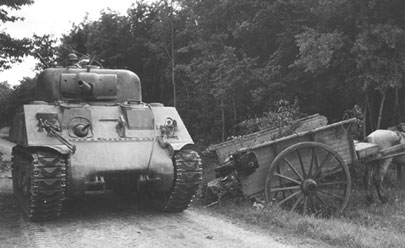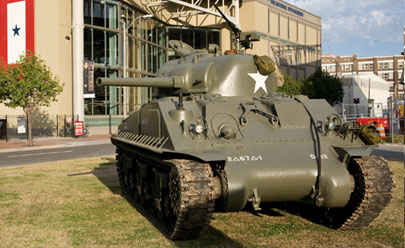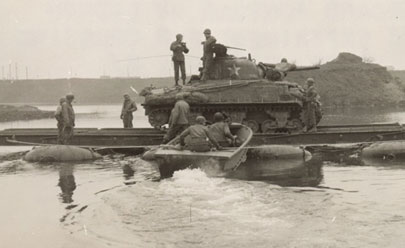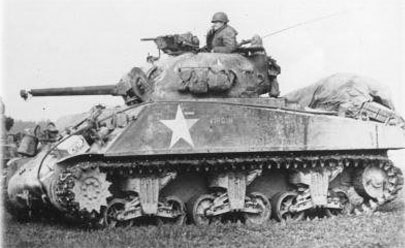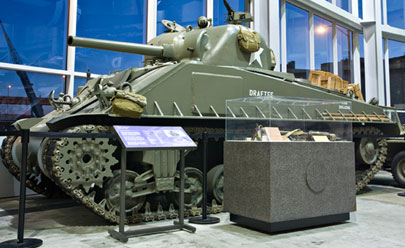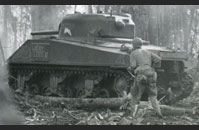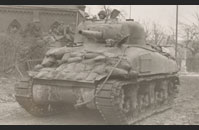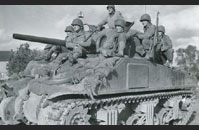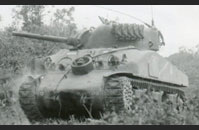FEATURED ARTIFACT: SHERMAN TANK
The Sherman tank was the most commonly used American tank in World War II. More than 50,000 Shermans were produced between 1942 and 1945. They were used in all combat theaters — not only by the United States, but also by Great Britain, the Free French, China and even the Soviet Union. Initially developed to replace the M3 "Grant/Lee" medium tank, the first Shermans were manufactured in 1942 and some early productions examples saw combat in North Africa in 1943. The model proved itself somewhat effective against German Mk II and Mk IV Panzers, but it was thoroughly outclassed by the Tiger, Panther and King Tiger tanks. Notorious for their flammability, Shermans were nicknamed “Ronsons” after a lighter with the slogan “lights every time.”
The Museum’s Sherman is an M4A3, built by Ford Motor Company in 1943. No unit markings were discovered when previous coats of paint were removed from the tank. Because the tank was manufactured in 1943, it is almost certain that it was deployed overseas during the war, although no battle damage was discovered.
When the Sherman tank arrived at the Museum in December of 2000, its engine was completely rusted and it was painted in a color appropriate to the Korean War era rather than World War II. Restoration work began in late October 2004, when the tank received a running Ford GAA engine and a new paint job. The tank was restored with the markings of an actual vehicle which served with D company, 1st Battalion, 67th Armored Regiment, 2nd Armored Division. The tank’s nickname, “Draftee,” is from a tank in the unit commanded by S/Sgt. Julian Czekanski of Cleveland, Ohio. It was common practice in the US Army and Marine Corps to have nicknames for armored vehicles. The names typically started with the letter of the company to which the vehicle was assigned.
Specifications: |
|
Weight |
33 tons |
Length |
19 feet 4 inches |
Height |
9 feet |
Width |
8 feet 7 inches |
Engine |
500 hp Ford GAA-III, V-W.C., V-8 |
Sustained Speed |
26 miles per hour |
Cruising Range |
130 miles |
Fuel capacity |
174 gallons |
Armament |
75 mm Gun; two .30 cal Browning machine guns; one .50 cal Browning machine gun |
Armor (Hull, Front, Upper) |
2 inches |
Crew |
5 |
Number Produced (M4A3) |
1,690 |
Gift of the Optimist Club of the West Bank, The National World War II Museum Inc., 2000.216
Acknowledgements:
More than 1,000 hours of staff and volunteer time was devoted to this restoration project.
Without the following volunteers who donated their time and skills to this project, this project would not have been possible: John R. Clements, Brandon Deshotel, Jason Frisch, Wes Gladhart, Louis S. Hembree, Eldon S. Huner, III, Eldon S. Huner, Jr., Ethan S. Lamb, Mark Mod, Claire Pitre, Elmon Randolph, Charlie Rome, and Peter Ward.
The National World War Museum would like to thank Mike and Jerry’s Paint and Supply, Crescent City Radiator and Rick Larson for their donations of goods and services in support of the Sherman tank restoration project.
Optimist Club of the West Bank:
Officers:
Robert Hebert President
Helen Depree Vice President
Ruth Tassin Vice President
Edna Guccione Secretary
Joseph Falcone Treasurer
Board of Directors:
Sylvia Ricks, Carolyn Boudreaux, Michelle Stephens, Joan Taravella, William A. Staehle III, and Neal Fromenthal
Members:
Yvette Aguilar, John Bertucci, Carolyn Boudreaux, Fred Brown, Deborah Carbo, Helen Depree, Joseph Falcone, Robert Fray, Neal Fromenthal, Lisa Grady, Teresa Grady, Edna Guccione, Robert Herbert, Calvin Kass, Denise Lacoste, Andrew Lukinovich III, Al Martinez, Kim Privitt, Kent Ricks, Sylvia Ricks, Charles Shano, Jr., William Staehle III, Joseph Stephens, Michele Stephens, Joan Taravella, Ruth Tassin, and Sam Trupiano
Additional Images:

